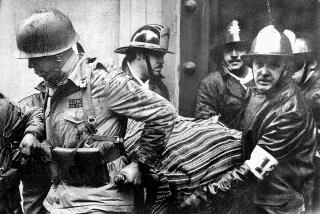Senate Panel Hears of Covert POW Hunt : Indochina: The 1981 mission into Laos sought to check apparent distress messages.
- Share via
WASHINGTON — A Senate committee investigating the fate of soldiers missing from the Vietnam War received a closed-door briefing from intelligence officials Friday on a covert mission into Laos that the CIA sponsored in 1981 to search for American POWs.
More than a decade later, the CIA still refuses to acknowledge publicly any connection with the mission, whose details remain classified. But former National Security Adviser Richard V. Allen confirmed in confidential testimony earlier this year that the mission was ordered by President Ronald Reagan after satellite surveillance detected what appeared to be a POW distress code stamped into the ground at a prison complex in southern Laos.
Testifying Thursday before an open session of the Senate Select Committee on POW-MIA Affairs, Assistant Secretary of Defense Duane Andrews said that what some analysts thought was a distress signal in the form of the number 52 may only have been “furrows in the ground” and that there was no evidence POWs were ever held there.
However, senators who attended the CIA briefing indicated afterward that they were skeptical of Andrews’ explanation, although they declined to disclose details.
“There certainly is evidence there may have been Americans . . . at least evidence that raised questions Americans may have been there,” committee chairman John Kerry (D-Mass.) said.
Sen. Robert C. Smith (R-N.H.), the committee’s vice chairman, said he was surprised by Andrews’ testimony because the CIA consensus at the time was that the satellite image of the Nhommarath camp showed a man-made sign, furrowed or stamped into the ground in an area in the compound where crops were grown.
CIA analysts at the time concluded that the numerals, each about six feet wide and 10 feet high, were designed to be visible from above, but undetectable to guards on the ground. They speculated that the “52” referred to a B-52 and was meant to indicate that crews from one or more downed bombers were held there.
“The genius of it,” Allen said in his closed-door testimony to the committee last June, was that it could be viewed only from above and it said “in effect, ‘Help’ . . . or ‘Here we are.’ ”
Allen said Reagan Administration officials were convinced from the intelligence that as many as 100 American POWs might have been housed at the camp, according to a copy of his deposition made available to The Times. He said Reagan authorized a reconnaissance mission to verify the suspicions, but the operation was bungled by the American and Laotian mercenaries who led it.
The team slipped into Laos from northern Thailand in May, 1981, but was discovered by Vietnamese soldiers and forced to retreat with several wounded. It subsequently returned to Laos and reached the camp, but found it deserted, according to Allen’s account.
Andrews told the committee that the consensus now is that the camp never housed American prisoners, but he offered no explanation why the facility, which CIA analyses said was constructed between 1978 and 1980 to hold about 200 prisoners, was suddenly abandoned.
Differing assessments of the satellite data are among many conflicts that the Senate committee is trying to resolve in its yearlong effort to determine the fate of the 2,226 Americans listed as missing from the Vietnam War. But with less than three months to go before the expiration of their mandate, members remain sharply divided over the most basic but emotional questions of whether prisoners were in fact left behind and if so, whether any could be alive today.
More to Read
Get the L.A. Times Politics newsletter
Deeply reported insights into legislation, politics and policy from Sacramento, Washington and beyond. In your inbox twice per week.
You may occasionally receive promotional content from the Los Angeles Times.










